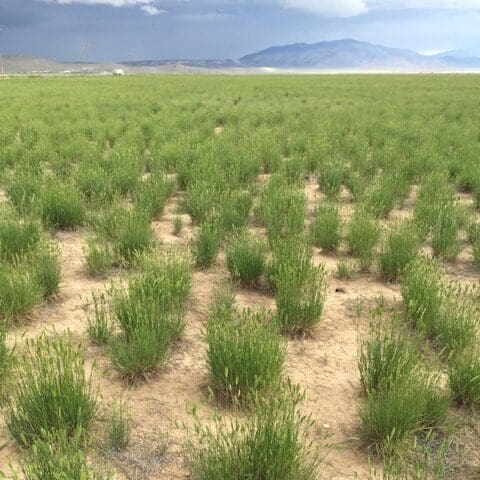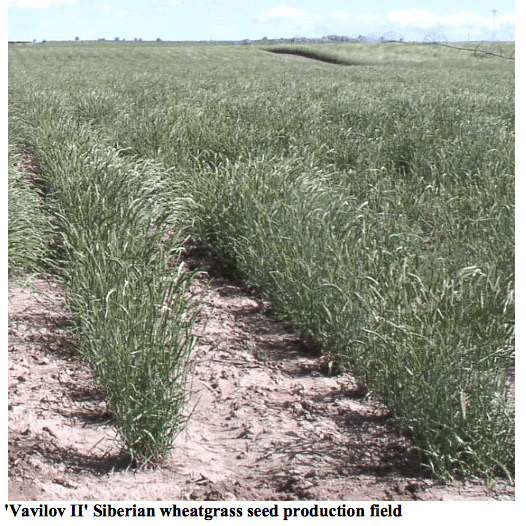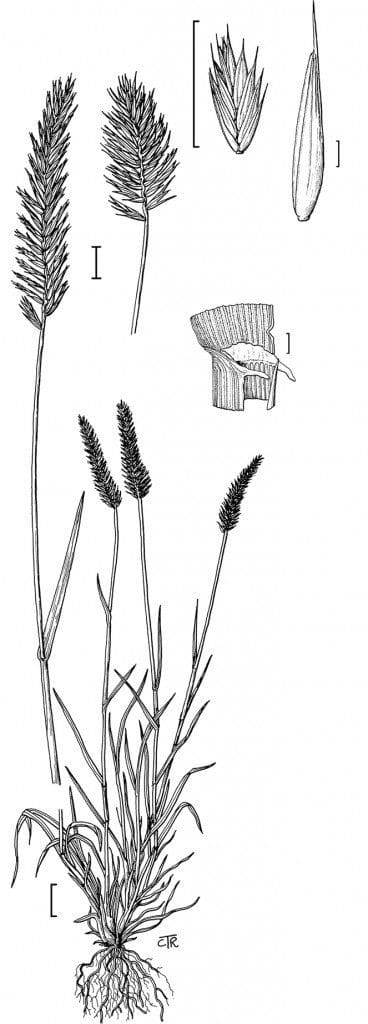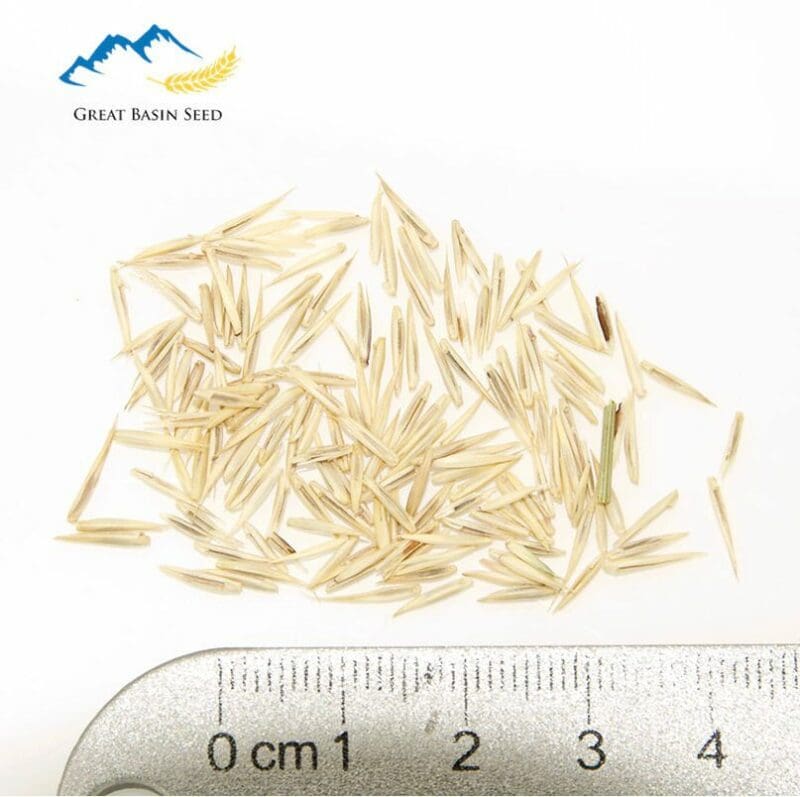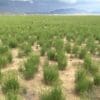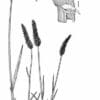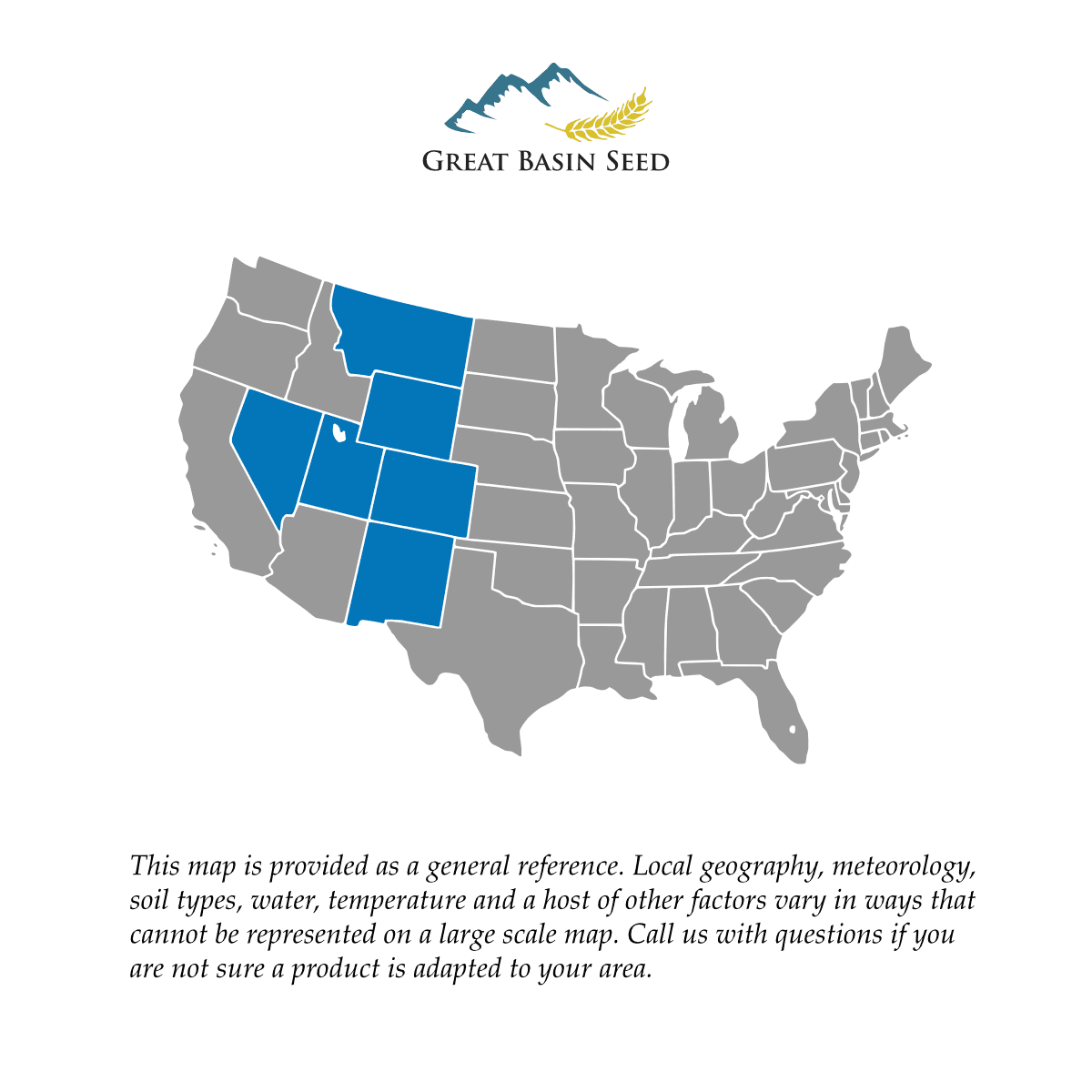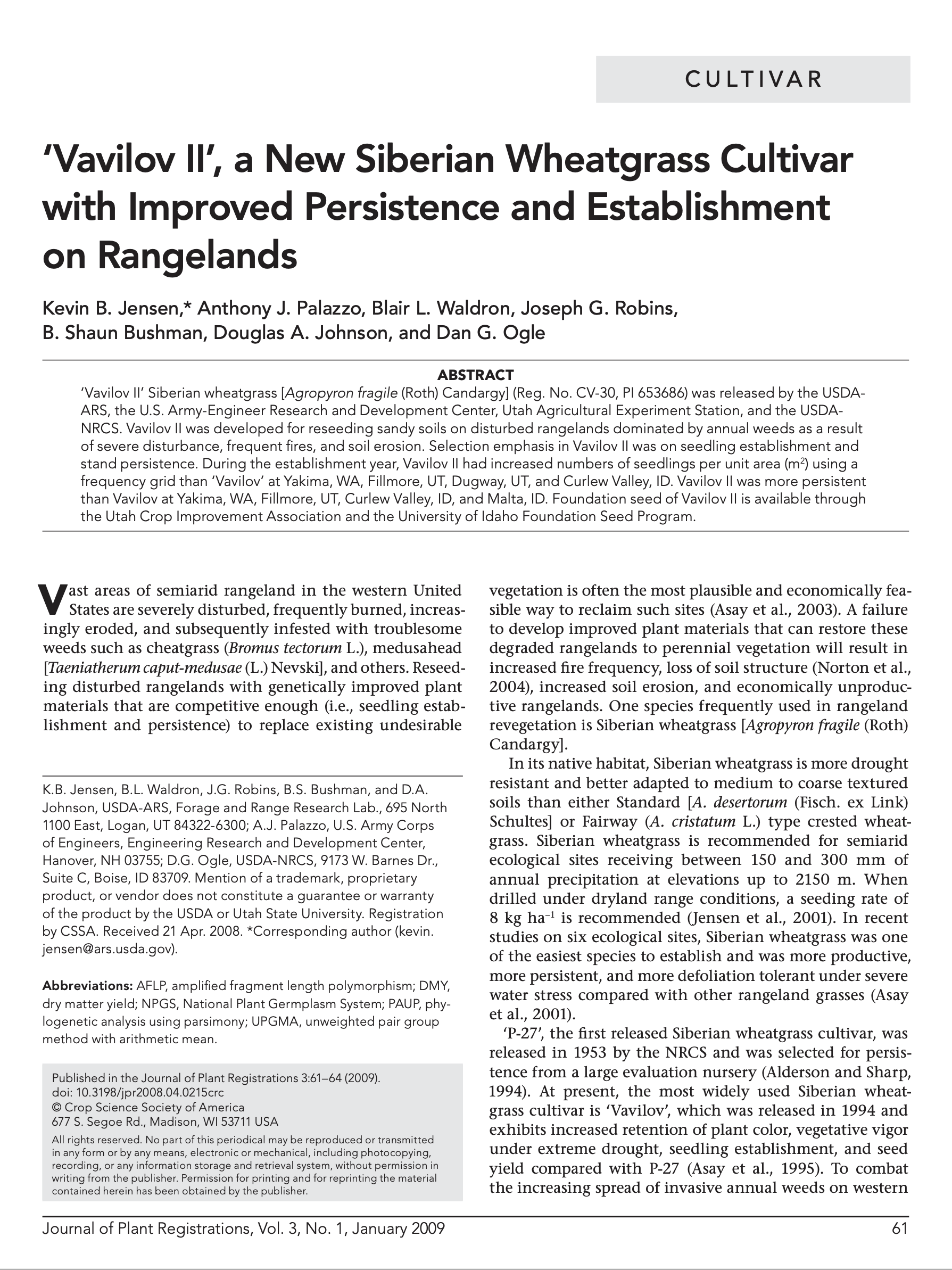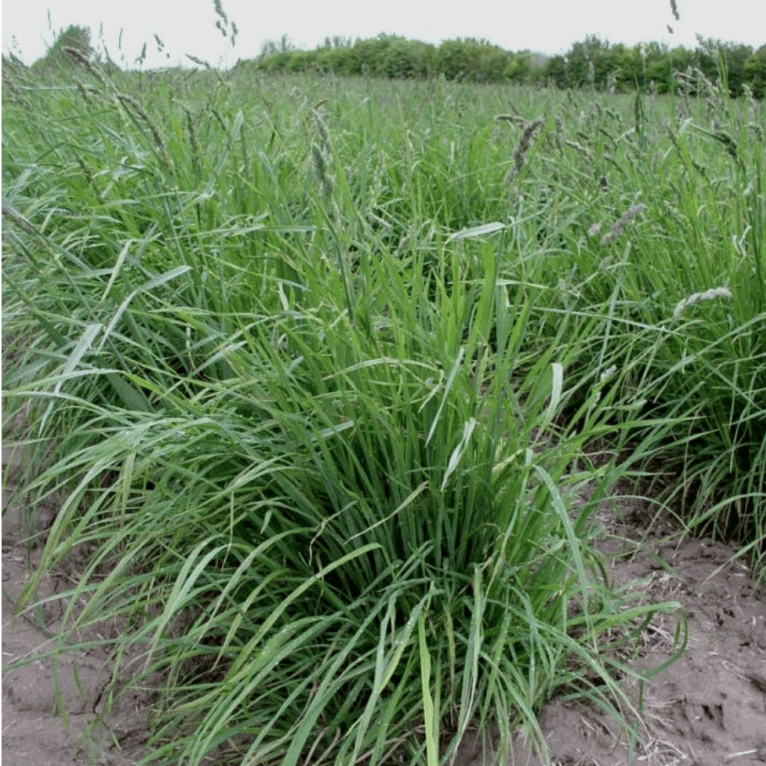Vavilov Siberian Wheatgrass
- Very drought tolerant bunchgrass
- Will survive on 5″ annual precipitation
- Recommended for forage production in arid locations
- Preferred feed for livestock and elk in spring and fall
- Excellent seedling vigor
- We offer the “Vavilov II” cultivar
Min. to Max. Annual Precipitation
32in.
Average Max. Height
Vavilov Siberian Wheatgrass is a perennial bunchgrass that is palatable, fine, and has a fibrous root system. It is a very drought tolerant species. Used and affective in sandy soils, disrupted soils, forage production in arid locations, reclamation, and urban areas. Preferred feed for cattle, sheep, horses, and big game wildlife. Not recommended for areas with more than 14 inches of annual rainfall. Very competitive and can out-compete slower developing native species.
Great Basin Seed offers the Vavilov II cultivar
Vavilov Siberian Wheatgrass (Agropyron fragile) is a very drought tolerant bunchgrass similar to Standard Crested Wheatgrass but finer and more palatable. It is also more drought tolerant…it will survive in areas of 6″ annual precipitation, making it one of the very best candidates for the arid lands of the West. Siberian Wheatgrass is a “staple” species at Great Basin Seed and is found in many of our dryland and reclamation seed mixes. It is widely used and loved by those who use it. We offer the improved ‘Vavilov II’ variety.
‘Vavilov II’ Siberian wheatgrass was released by the USDA-ARS, the U.S. Army Corps of Engineers-Engineer Research and Development Center, Utah Agricultural Experiment Station, Utah State University, and the USDA-NRCS in 1994. It was developed from collections originating from the former USSR, Turkey, and from P-27. It excels for use on arid and semiarid rangelands as a rapidly establishing revegetation grass in the Intermountain West, Great Basin, and Northern Great Plains regions of western United States. It was evaluated to identify resilient plant characteristics and develop wear-resistance for use on military training lands. It was selected for stand persistence and seedling establishment in response to drought. Seedling vigor is similar to ‘Hycrest’ and ‘Hycrest II’ crested wheatgrass and it is consistently better than ‘P-27’. It is more drought tolerant and better adapted to sandy soils than other crested wheatgrasses. It is best adapted to 8 inches and above annual precipitation and elevations below 7,000 feet. It is noted for tolerating longer drought periods once established than crested wheatgrass.
Siberian Wheatgrass is a perennial, introduced grass. It is commonly seeded in the arid sections of the Western United States. Vavilov Siberian wheatgrass is commonly recommended for forage production in arid locations. It is palatable to all classes of livestock and wildlife. It is a preferred feed for cattle, sheep, horses, and elk in spring and also in the fall if additional growth occurs from late growing season rainfall. It is considered a desirable feed for deer and antelope in spring and again in fall, if additional growth occurs. It is generally not recommended in areas with more than 14 inches of annual rainfall because better alternative forage species are available.
Siberian wheatgrass is well adapted for the stabilization of disturbed soils. It competes well with other aggressive introduced plants during the establishment period. Siberian wheatgrass is generally less desirable in mixes with native species because it is competitive and can out-compete slower developing native species.
Its drought tolerance, fibrous root system, and excellent seedling vigor make Siberian wheatgrass ideal for reclamation in areas receiving 8 inches or more annual precipitation. This grass can be used in urban areas where irrigation water is limited to provide ground cover, weed control and to stabilize ditch banks, dikes, pipelines, power lines, and roadsides. In revegitative projects, Siberian Wheatgrass has gained favor over other species of wheatgrass.
Where it is planted as a monoculture, the resulting biodiversity is lower than that found in a diverse seeded or native plant community.
Also known as Agropyron sibericum. Agropyron fragile
***Click on the “Quick Plant Facts” tab above for more information.
Table of all Crested, Desert and Siberian Wheatgrasses
| Common Name & Variety | Scientific Name |
|---|---|
| Crested Wheatgrass | Agropyron cristatum |
| Douglas | Agropyron cristatum var. douglas |
| Ephraim | Agropyron cristatum var. ephraim |
| Roadcrest | Agropyron cristatum var. roadcrest |
| Parkway | Agropyron cristatum var. parkway |
| Ruff | Agropyron cristatum var. ruff |
| Desert or Standard Crested Wheatgrass | Agropyron desertorum |
| Nordan | Agropyron desertorum var. nordan |
| Summit | Agropyron desertorum var. summit |
| Siberian Wheatgrass | Agropyron fragile |
| Vavilov | Agropyron fragile var. vavilov |
| Vavilov II | Agropyron fragile var. vavilov II |
| P-27 | Agropyron fragile var. P-27 |
| Hybrid Crested/Desert Wheatgrass | Agropyron cristatum X Agropyron desertorum |
| Hycrest | Agropyron cristatum X Agropyron desertorum var. Hycrest |
| Hycrest II | Agropyron cristatum X Agropyron desertorum var. Hycrest II |
| CD II | Agropyron cristatum X Agropyron desertorum var. CD II |
‘Vavilov II’ Siberian Wheatgrass NRCS Plant Release
‘Vavilov II’ Siberian Wheatgrass NRCS Plant Release
PDF version of NRCS Release Brochure
Citation: USDA-Natural Resources Conservation Service, Aberdeen Plant Materials Center. Aberdeen, Idaho 83210. Published December, 2012
‘Vavilov II’, a New Siberian Wheatgrass Cultivar with Improved Persistence and Establishment on Rangelands
‘Vavilov II’, a New Siberian Wheatgrass Cultivar with Improved Persistence and Establishment on Rangelands
PDF version of Vavilov II cultivate release, published in Journal of Plant Registrations, Vol. 3, No. 1, January 2009
Kevin B. Jensen,* Anthony J. Palazzo, Blair L. Waldron, Joseph G. Robins, B. Shaun Bushman, Douglas A. Johnson, and Dan G. Ogle
Helpful Links
Additional information about this product can be found on the academic websites linked below.
Synonyms
Many plants have more than one common and scientific name. We've listed a few of them below.
- Vavilov Siberian Wheatgrass
- Agropyron fragile
Who is Great Basin Seed?
Great Basin Seed is a seed company that specializes in seed sales and consultation for home, ranch, farm, range and reclamation. We have been a leader in the seed industry since 1974.
Our History
We've been in the seed business since 1974.
What We Offer
We offer seed for home, farm, ranch, range and reclamation projects.
Meet the Gang
We have the best employees in the world! We are proud of the work they do, and trust them to serve you!
Right: Company founder Lloyd and his wife Paula Stevens in a wildflower seed production field circa 1977
Quick Plant Facts
| Common Name: | Siberian Wheatgrass |
|---|---|
| Scientific Name: | |
| Old Scientific Name: | |
| Min. Precipitation | 6 Inches Minimum |
| Growth Season: | |
| Root Form | Bunchgrass with Fibrous roots |
| Best SowingTime | Fall |
| Seeds per Pound: | |
| Sowing Rate | 15-20 lbs. per acre as a stand-alone planting |
| Growth Height: | |
| Plant Type: | |
| Origin: | |
| Lifespan: | |
| Available Varieties: | |
| Max Sowing Depth: | |
| Hardiness Zones: |
